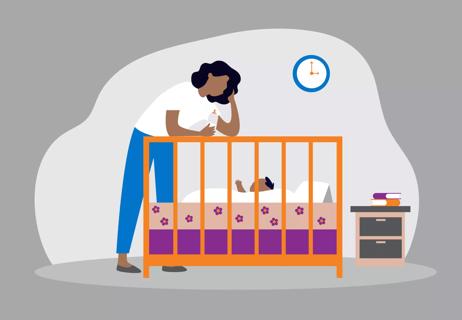Change your toothbrush after an infection and always take your full course of antibiotics to help ward off recurrence

Your kid finished the antibiotics. But now, they’re running a fever, their lymph nodes are the size of grapes and they’re complaining that it feels like there’s sandpaper in their throat.
Advertisement
Cleveland Clinic is a non-profit academic medical center. Advertising on our site helps support our mission. We do not endorse non-Cleveland Clinic products or services. Policy
It can’t be happening again. Can it? Can you get strep throat twice?
Yes, yes you can. You can also get strep three times. Four times. Over and over and over again, really.
Because the bacteria that causes strep (group A Streptococcus bacteria) is a tricky little bugger.
We talked with pediatrician Kristin Barrett, MD, about what causes recurring strep throat. And what to do when strep throat comes back.
There are a few reasons strep throat (also called streptococcus pharyngitis) can come back.
But let’s start at the beginning: What happens when you get strep the first time? Because that can give us a clue as to why it happens a second time.
Strep throat is caused by bacteria. And it’s a kind of bacteria that healthcare providers, like pediatricians, will typically treat with antibiotics. Not because strep can’t go away without medication. It could. But a bad case of strep that goes untreated can lead to other problems.
“We treat strep throat because of the complications that can happen when it’s not treated,” Dr. Barrett explains. “To fight off strep, your immune system builds a very strong reaction. The antibodies against strep can conglomerate and form complexes that can wreak havoc throughout your whole body. That can lead to things like rheumatic fever, kidney damage, trouble with your heart valves and more.”
Advertisement
Babies and toddlers under 3 are far less likely to have strep complications. So, it’s typically not tested for in little ones.
But when older kids and adults are positive for strep, they typically are prescribed antibiotics. And within a day or two, you’re feeling better.
Great!
But. Then, it can come back. Why? Let’s take a look.
You know those warning labels on your antibiotics? The ones that remind you to “take as prescribed” and “finish all medication”?
They’re there for a reason.
When you start antibiotics for strep throat, you’ll probably start feeling better pretty fast. Even within 12 to 24 hours. Most recommendations even say you can send your kid back to school within 12 hours of their first dose.
Even still, it’s important to finish the full course of antibiotics.
Because even if you’re feeling well, strep bacteria can still lurk in your body. Without the proper dose of bacteria-killing antibiotics, strep bacteria can pop back out of hiding. And just like that, you’ll feel the symptoms of a strep infection all over again.
Amoxicillin (a form of penicillin) is the “gold standard” antibiotic for treating strep.
But not everyone can take it.
“There are almost no reported cases of amoxicillin-resistant strep throat,” Dr. Barrett reports. “But it gets more complicated when you have people who are allergic to penicillin, which is rather common. Most other antibiotics can be less effective at treating strep due to bacterial resistance.”
If you get strep throat a second time after taking a full course of amoxicillin, chances are it’s not because the antibiotic didn’t work. But if you were prescribed another kind of antibiotic, it might take a second course or a change in antibiotic to knock the infection out.
Here’s something you might not know: Some people have strep bacteria creeping around their tonsils on a good day. They just ... live there.
“If someone is a carrier for group strep A, that means they have strep bacteria living in their oral pharyngeal cavity all the time. It doesn’t necessarily cause infection symptoms, though,” Dr. Barrett explains. “But if a carrier goes to their healthcare provider with a sore throat and gets a strep test, it’s going to come back positive. The test is screening for the bacteria, and they always have the bacteria present.”
Here’s how that plays out: The carrier (who may not know they’re a strep carrier) gets antibiotics for their sore throat. But the sore throat remains. Likely because their symptoms were caused by a virus, not the strep bacteria. And antibiotics don’t treat viral infections.
So, they go back to their provider. They get another strep test, and — wouldn’t you know it — they’re positive for strep again. Not because they’re truly infected. Not because strep is causing their sore throat. But simply because they’ll always test positive for strep.
Advertisement
Researchers estimate that as many as 25% of children are carriers of strep throat.
How do you know if that’s what’s causing recurring cases of strep in your family?
“If we think a case of recurrent strep could be consistent with a carrier state, I ask people to come back in a few weeks, when they’re not having symptoms. Then, we swab them again. If that test comes back positive, we know that they’re likely a strep carrier,” Dr. Barrett states.
Strep is highly contagious. And it can linger around.
Sometimes, even with a full course of amoxicillin, strep bacteria can just worm their way back in.
Your child can get better and, within days, can get infected again by a strep bug running through school.
Or it can stay in the family. One kid gets strep and starts on antibiotics. Before you know it, their sibling gets strep, too. And now, the first kid has it all over again.
It’s even possible to reinfect yourself. That’s right. Strep bacteria can live on surfaces for several days. One of the most likely places for it to hang out? Your toothbrush.
“We always recommend replacing your toothbrush by the end of strep treatment,” Dr. Barrett advises. “It’s a very likely place for strep bacteria to hang around and reinfect you.”
Advertisement
If you’re of a certain age, you might remember when tonsillectomies (tonsil removal) to treat recurrent strep throat were all the rage. It was almost like a rite of passage to be tonsil-free by middle school.
That’s changed over the years.
“The recommendations have gotten a lot more stringent,” Dr. Barrett reports. “The current recommendations are that tonsillectomies are typically reserved for people who have seven episodes of strep throat within a single year, five cases in two consecutive years or three cases in three consecutive years.”
Why?
Researchers have shown that tonsil removal didn’t make much difference for that many kids.
“In the long term, we’ve seen that taking the tonsils out really didn’t ultimately help kids miss less school. Kids who got their tonsils out weren’t less likely to get sick,” Dr. Barrett clarifies. “It’s an invasive surgery and the benefit wasn’t worth it in the long term.”
So, what can you do when your kid is getting recurrent cases of strep, but isn’t at the tonsil-removal level?
Dr. Barrett suggests these strep-fighting steps:
Advertisement
Whether it’s your first round of strep or your fifth, strep isn’t a fun time. But taking some preventive measures to stop the cycle can make a difference.
If you’re dealing with recurrent strep, talk with a healthcare provider. They can help make sure you’re getting the treatment you need to ward off complications and help keep you healthy.
Learn more about our editorial process.
Advertisement

It’s uncommon in kids under 3, but providers may test under certain circumstances

The short answer from a pediatrician

The emergency room is for serious medical issues; urgent care can help when you can’t get a quick appointment with your child’s doctor

If your nose is constantly running, it could be allergies, chronic sinusitis, nasal polyps or other concerns

Honey can help make a sore throat more bearable by tamping down inflammation and coating your throat

If you have other cold and flu symptoms, it’s probably not strep

Lice don’t jump — but they can spread with direct head contact

Some warts will clear up on their own, but others may need home remedies or medical care

Babies can get congested easily, but you can calm their cough by keeping them hydrated, using nasal drops and running a humidifier

Weight loss may cause loose, sagging skin and muscle loss to your rear

Several conditions, like vitiligo and fungal infection, can cause a loss of pigmentation, leading to white spots or patches on your skin